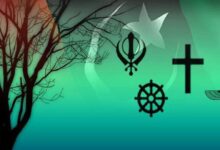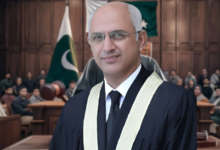Journalists in Pakistan walk a tightrope
Islamabad emerged as the most dangerous place for journalists to practice journalism:FN
On February 16, 2020, he asked his colleagues to drop him at a venue where he was supposed to join his other family members, but he could never reach there, because anti-elements had kept a death-trap ready to silence his voice against corruption and mismanagement in Sindh.
After a few hours of his drop at the location, the police found his body floating on nearby river water. He was not an ordinary person, he was part of Pakistan’s fourth pillar [media], but his murder case is closed in files.
The victim, Aziz Mammon, was working with KTN and Daily Kawish, a Sindhi language news media outlet. He was receiving life threats for his undeterred reporting against bad- governance, corruption and nepotism. Who is the murder of Mammon, journalist community in Pakistan raises finger on the suspected role of the party in Sindh.
Likewise dozens of other journalists who have stood the victim of fair play with their profession, Mammon’s murderers could not be exposed and brought to justice and his case is closed in files.
In Pakistan, journalists confront fatal safety risks in the line of their duty and they are left at the mercy of various pressures such as extremist groups, kidnappers, who even don’t hesitate murdering them with almost total impunity.
A recent report of Freedom Network shows that as many as 91 cases of attacks and violations against journalists and media practitioners were reported in Pakistan during the last one year.
The research report is based on the records collected between May 3, 2019 and April 10, 2020.
This is an average of over seven cases of violations a month – one every fourth day, or twice a week. At least seven journalists lost their lives in line of their journalism, two cases of abductions, nine cases of arrests, detentions or confinements, 10 cases of physical assaults, half of which caused severe bodily injuries, one case of the attack on home of a journalist, 23 cases of specific written or verbal threats, 10 cases of censorship, and eight instances of legal cases registered against journalists.
Asad Toor, a producer at Aaj TV and host of a current affairs program at an online platform, with about 25,000 subscribers, was beaten to injure in his apartment. Instead he gets justice; he has been confronting trolling on social media as he doubts involvement of the sensitive departments and the government.
“It is disturbing that the space for dissent and providing public importance information is rapidly shrinking in Pakistan as well as human rights defenders particularly at risk of censorship, physical violence, and arbitrary detention,” said Sam Zarifi, Secretary General of the International Commission of Jurists.
Pakistani journalists have long-faced serious obstacles to their work, including harassment, threats, assault, arbitrary arrest, detention, abduction, and death.
As these threats have escalated, Pakistani authorities have also increasingly pressured editors and media owners to shut down critical voices.
Similarly, on May 29, Jang Group of Media suspended Hamid Mir, a Pakistan’s known anchor and vocal to freedom of expression and speech after he spoke at a protest in solidarity with the journalist Asad Toor.
Asma Sherazi also faced online bullying. Here is not the end, some youtubers liable her as an agent of a neighboring country and tried hard to prove her as anti-state women. All three journalists belong to the capital city of Pakistan.
Therefore, Islamabad has emerged as the most dangerous place to practice journalism in Pakistan with 34 per cent of the violations. Out of a total, 91 violent incidents against journalists, 31 were reported in Islamabad.
Sindh remained the second worst place for journalists with 27 per cent incidents of violence against journalists, closely followed by Punjab with 22 per cent, KP with 14 per cent and Baluchistan with 3 percent, as per FN report.
After struggling with years of systematic wage theft, Media workers in Pakistan are also facing some of the worst economic pressures aimed covid-19 pandemic.
Those who have protested for non-payment of their dues have even been laid off without clearing their outstanding dues. This has forced a large number of journalists to look for other streams of income such as video blogging on social media while others are driving cabs or have opened shops to feed their families.
In Pakistan, 65 per cent journalists who are murdered were political beat reporters, while 19 per cent were covering corruption, according to CPJ.
According to the Pakistan Federal Union of Journalists (PFUJ), the number of female journalists in Pakistan is just 5 per cent.
No media house feels comfortable or trust female journalists for field reporting, especially in sensitive areas.
Female journalists in Pakistan are continuously facing harassment, cyber-bullying, low wages, and merit-based positions in media houses.
The government has used a 2016 cybercrime law as a pretext to target anti-government content online. But a new bill could make the environment even worse for journalists by centralizing government oversight of the media under a single authority and increasing outlets’ dependence on the state.
As a media analyst, Huma Yusuf wrote in a column this week, “What better way to turn media outlets into state mouth-pieces than by making them entirely reliant on the government to stay in business?” During a meeting with President Donald Trump in 2019, Imran Khan said Pakistan boasts “one of the freest presses in the world.”
The media oversight bill could become one more powerful data point for those that derided him. In fact, under Khan’s supervision, Pakistan’s press freedom looks to get even worse.
Pakistan Press Foundation has recently passed a journalists protection bill from the Sindh Assembly, which is a fresh breeze indeed in the suffocated Media environment in Pakistan.
The country’s press experienced the worst ever censorship in the current regime led by Imran Khan. According to an international watchdog, the PTI government refuses this report, but can never deny the ground realities.
Hamid Mir, Asad Toor, Asma Sherazi and Absar Alam are the voices of prominent journalists but there are a lot more unheard voices of journalists who are killed, tortured, harassed and kidnapped, still waiting for justice.





